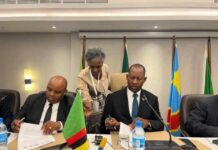
By Sgt. Terry Rajsombath for U.S. Army Africa Public Affairs
LUSAKA, Zambia – “Ready! Position! Charge one, elevation 11-38,” said the mortar team as they readied to launch an 81mm training mortar during a cross-training exercise between U.S. and Zambian Soldiers on Aug. 5, at the Nanking Training Area.
The commands could be from any U.S. Army mortar team but these were delivered by the mortarmen of the Zambian Defense Force during Southern Accord 2015, an annual exercise aimed to increase interoperability between U.S. and African partner nation forces.
“We have this type of cohesion even though we’re different armies,” said Spc. Chris E. Vong, of San Jose, Calif., a mortarman assigned to A Troop, 2nd Squadron, 13th Cavalry Regiment.
Despite the cultural differences, their roles as mortarmen and as Soldiers helped bridge the cultural gap, said Vong.
The initial meet-and-greet between the U.S. and Zambian Soldiers started off with slow conversations but swiftly turned into easy and open discussions about their hometowns and experiences as mortarmen, said Vong.
“They’re old school in their tactics, but they’re a lot like us,” said Vong.
Dry runs and rehearsals kicked off the exercise, culminating in a live-fire event. Two mortar crews from each country fired 81mm high-explosive mortars at a target approximately 1500 meters from their position. Leading each mortar team were experienced officers and Soldiers.
“Some of their NCOs have 20-plus years of being a mortarman,” said Vong. “They taught us new techniques and we taught them new techniques.”
Vong said the only challenge he found working with the Zambian Soldiers was a minor language barrier. Although English is the official language in Zambia many different dialects and languages are spoken within the country. Bemba and Nyanja are two of the major languages commonly spoken.
By living beside one another, U.S. and Zambian Soldiers overcame minor language barriers and built strong connections with one another, said Vong.
“There is a similarity, maybe not in terms of technology, but as the army, our training is almost the same,” said Staff Sgt. Lubinda Mufngulwa, a ZDF non-commissioned officer.
Despite differences in technology and equipment between the two armies, their fighting spirit is “on the same foot,” said Mufngulwa.
Pfc. Brian Curnow, of Lodi Calif., a mortarman assigned to A Troop, 2nd Squadron, 13th Cavalry Regiment agreed with Mufngulwa.
Despite differences in tactics and technology, the U.S. and Zambian Soldiers were able to unite, accomplish missions and learn from one another, said Curnow.
Despite cultural differences between the U.S. and Zambian forces, Soldiers were able to identify with one another as professionals. U.S. and Zambian forces share the same values of respect, loyalty and commitment, said Curnow.
Lance Cpl. Pythiaus Zulu, a ZDF Soldier, said that regardless of language, their roles as professional Soldiers allowed the U.S. and Zambian forces to communicate as brothers-in-arms.
“I’m sure whether we are an English-speaking country or not, we could communicate and we would not have a problem,” said Zulu.
For Zulu, a rifleman who has deployed three times, Southern Accord 2015 was his first multi-cultural, joint exercise.
“You know, we just feel we are one,” said Zulu. “This exercise is helping us, both Americans and Zambians.”
Southern Accord 15 is a joint-training exercise with more than 800 participants from 10 participating nations: Angola, Botswana, Malawi, Namibia, Tanzania, Zambia, United Kingdom, the Netherlands, U.S. and Germany.
The aim of the exercise is to enhance U.S. and African forces’ capabilities and increase their ability to operate together in support of peacekeeping operations
photo by U.S. Air Force Staff Sgt. Brian Kimball
usaraf.army.mil

 JOIN DRIVERN TAXI AS PARTNER DRIVER TODAY!
JOIN DRIVERN TAXI AS PARTNER DRIVER TODAY!











I dont trust those instructors